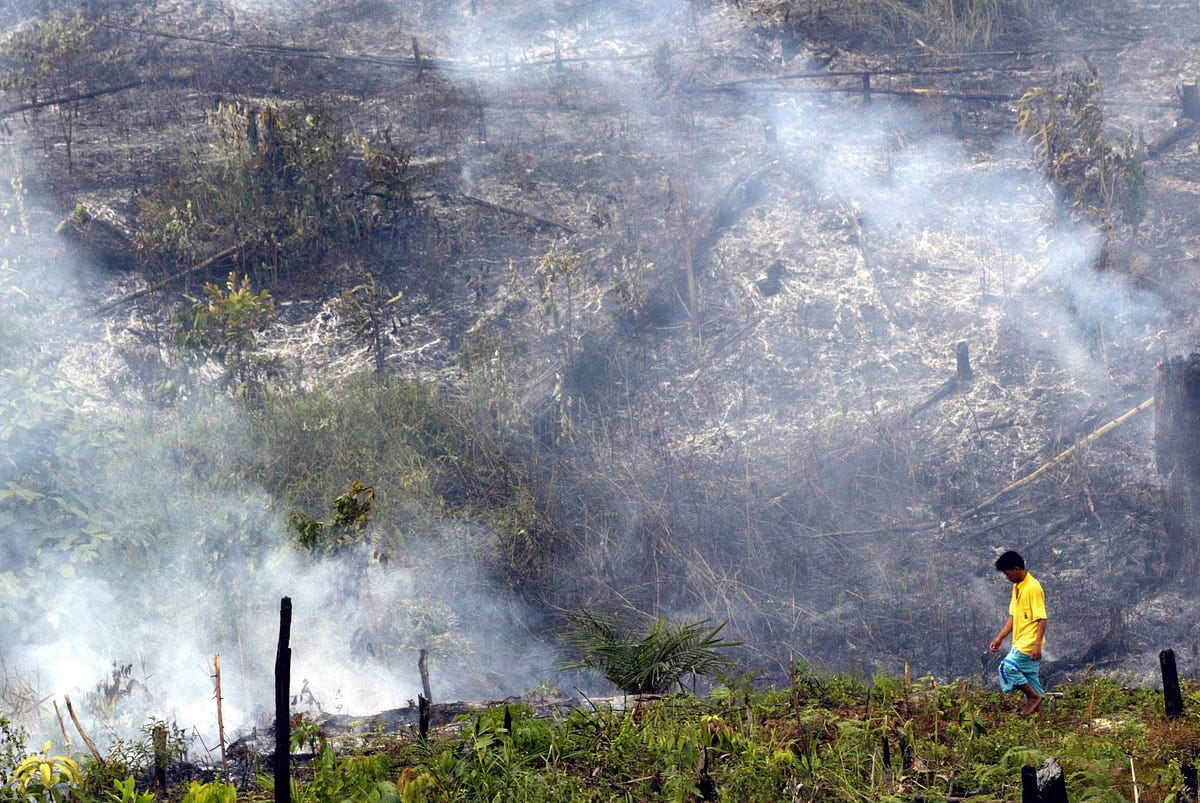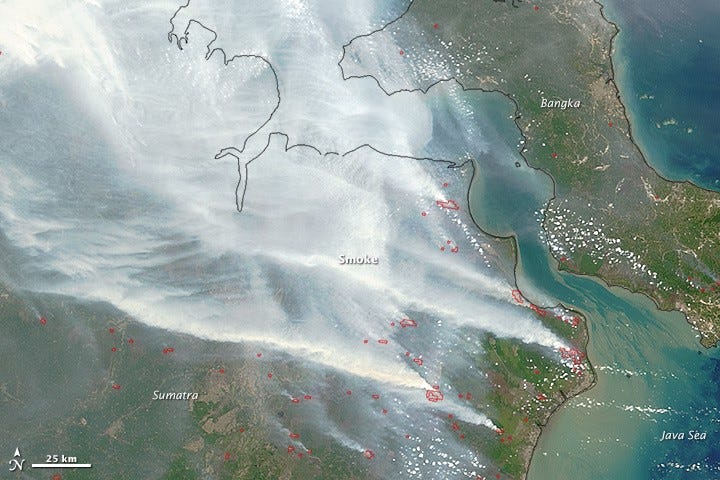
A man walks past smoldering forest lit for land-clearing in Minas, Riau province, Sumatera, Indonesia CREDIT: AP/TATAS SYUFLANA
Fires associated with palm oil and timber are mostly to blame, new study finds...
Smoke haze from agricultural fires may have caused more than 100,000 premature deaths across Indonesia, Malaysia, and Singapore last fall, a Harvard study published Monday found.
Fires started by Indonesian farmers, especially those working in palm oil and timber for wood pulp and paper, are mostly to blame, researchers said. “There is a lot of timber burning in those regions, and I think that’s surprising because timber is a much younger industry in the region,” said Shannon N. Koplitz, lead author of the study, in an interview with ThinkProgress.
Land use, including peat and forest fires, accounts for 63 percent of Indonesia’s emissions. Indonesia, which has a long history of slash and burn techniques to clear land for palm oil and wood pulp producers, is the sixth-largest emitter in the world.
Last fall, Indonesia went through the worst outbreak of forest fires in nearly two decades, as unusually warm and dry temperatures brought by El Niño exacerbated fire conditions. The fires, which largely happened in the coastal peat forests and likely stemmed from slash and burn, destroyed thousands of acres of peat forest — one of the world’s most effective carbon sinks — releasing tons of carbon, and massive quantities of small particulate matter called PM 2.5.
According to the Environmental Protection Agency, PM 2.5 can be carried long distances by wind and can damage soil, crops, and wildlife when it settles on ground or water. PM 2.5 can also reach deep into the lungs and bloodstream of humans, causing a long list of ailments such as decreased lung function, heart attack, aggravated asthma, and premature death.
Using computer modeling that scientists said could help Asian governments identify in real time fires with the highest damage potential, researchers discovered Indonesia suffered most of the health impact. More than 91,000 deaths were connected to the smoke haze in Indonesia alone. Another 6,500 deaths occurred in Malaysia, and 2,200 in Singapore.
“The goal of this work is to offer something that can be used now by policy makers, by stake holders, to try to aid on these [firefighting] efforts, because it seems that is just an overwhelming challenge to deal with these fires when they start,” Koplitz said.
That comes as peat fires burn at relatively low temperatures and can smolder for weeks or even months before extinguishing, emitting smoke the entire time. “The fire can be burning and then go basically underground, and be virtually undetectable by the firefighters, and then it can kind of move around and reignite days later in a separate location,” she said.

Smoke map of the Indonesia fires of late 2015. CREDIT: HARVARD UNIVERSITY
Harvard researchers also found the fires are becoming much more severe: In 2015, Indonesia forest fire smoke caused more than twice the number of premature deaths caused by similarly large fires in 2006.
“Carbon emission in Indonesia on a single day this past fall exceeded or were like eight times higher than the total carbon dioxide emissions from the [Sierra Nevada] Rim Fire,” Koplitz said, referring to one of the largest wildfires in California’s history.
Indonesia’s fires have major implications beyond the poor air quality that is known to shut schools and businesses, ground planes, and see tens of thousands seeking medical treatment for respiratory illness in numerous Asian countries.
“There are big implications for [the] climate,” Koplitz said, adding that the fire emissions “are significant enough to basically jeopardize the ability of Indonesia to meet their carbon goals.”
Indonesia has a moratorium in place on clearing primary forests, which are forests that have never been cleared or disrupted. Converting peat bogs, a type of wetland and an effective carbon sink that can release large amounts of carbon when burned, is also banned. Moreover, under its submitted emissions pledge to the United Nations, Indonesia said it will continue to reduce deforestation.
And yet, according to the Harvard study, concessions — land granted to industry for development — play a substantial role in industrial fires and the subsequent pollution. For instance, in Sumatra, an island in western Indonesia, timber concessions caused 27 percent of the 2006 haze. In 2015, that figure climbed to 55 percent.
“If nothing changes, this killer haze will carry on taking a terrible toll, year after year. Industry and government must take real action to stop forest clearing and peatland drainage for plantations,” Greenpeace Indonesia forest campaigner Yuyun Indradi said in a statement.

To help do something about the climate change and global warming emergency, click here.
Sign up for our free Global Warming Blog by clicking here. (In your email, you will receive critical news, research, and the warning signs for the next global warming disaster.)
To share this blog post: Go to the Share button to the left below.

Be the first to comment
Sign in with